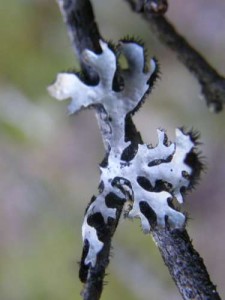Lichens are hardy and unusual organisms. They are made of algae and fungus, survive drought and extreme temperatures and can grow on man-made structures.

Some lichens are shown to break down the prions that cause chronic wasting disease. Photo: U.S. Geological Survey
“They’ve been opened up to the vacuum of space, and they’ve survived that,” said Christopher Johnson, research biologist at the U.S. Geologic Survey National Wildlife Health Center in Madison, Wis.
And they might be the key to solving one of Wisconsin’s burgeoning wildlife issues — chronic wasting disease.
“We’ve found that some of the lichen we’ve studied contain an enzyme capable of cutting up and degrading the causative agent of chronic wasting disease,” Johnson said.
The lichens were all found in Wisconsin, and broke down prions at normal Wisconsin temperatures.
Chronic wasting disease attacks the brains of deer, moose and elk. It was first identified in Wisconsin in 2002, and has appeared in Illinois, New York, Michigan and Minnesota.
It’s spread by misshapen prions, or proteins, that are transmitted from infected animals to healthy ones through contaminated urine, saliva and feces.
“The bad form of the protein interacts with the healthy form of the protein when it enters the body,” Johnson said. “It converts the healthy protein into another molecule of the bad protein, which can go on to convert more of the good form. That domino effect eventually leads to disease.”
The tricky disease is spreading through the Wisconsin deer population, infecting the unlucky animals that pick it up.
“There are no survivors,” said Bryan Richards, chronic wasting disease project leader and wildlife biologist at the Center.
Animals carry the disease for approximately two years, but because the effects are hard to identify until the latest stages, the illness is hard to recognize.
But the signs are clear by the last 10 weeks of a diseased animal’s life.
“They look like a walking bag of bones,” Richards said. “There is nothing about that animal that looks right.”
Hunters should be concerned about chronic wasting disease spreading through the region, or to the table, Richards said.
“We haven’t witnessed disease in humans yet, but we can’t rule it out.”

Chronic wasting disease has been observed in Wisconsin, Illinois, Minnesota, New York and Michigan. Photo: U.S. Geological Survey
Hunters can have their deer tested for the disease, but Johnson said the tests are not as responsive as they need to be.
“There are extremely sensitive tests for other pathogens, and we just don’t have it for prions,” Johnson said.
Humans can also spread the disease faster and farther. By tossing the unused parts of a cleaned deer, hunters can unknowingly introduce the disease to a new environment.
But with more research, Johnson hopes to control chronic wasting disease and break down the prions that cause it. Researchers are working on cloning the enzyme in lichens that break down prions. Then the enzyme could be used to treat contaminated areas.
Johnson also wants to see if animals that eat the lichens that break down chronic wasting disease are more resistant to the prion.
Although the lichen discovery is exciting, Richards doesn’t think it’s the definitive step in chronic wasting disease management.
“The idea that we could use it across all southern Wisconsin might be a leap of faith,” Richards said. “It’s still worthwhile and necessary that we look at other control techniques because we have not been very successful at managing this disease through traditional means.”
The current means of control is lowering the deer population, which is unpopular for many hunters.
Johnson is looking into the possibility of the disease spreading to other animals, especially native rodents like voles and deer mice.
“We really don’t know what is going to be the long term impact of chronic wasting disease on other species,” Johnson said. “What else might be able to get it?”
